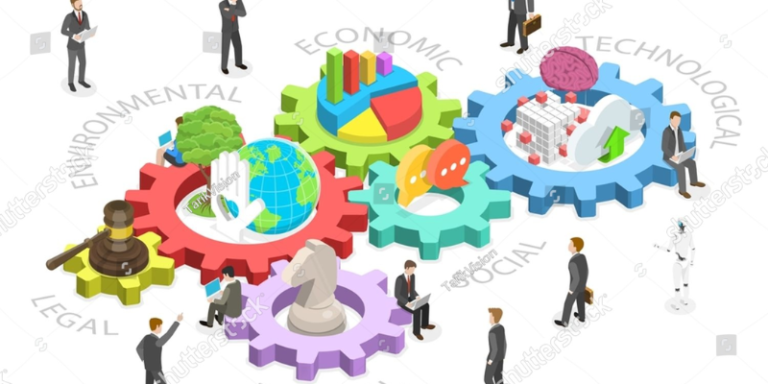The business environment is a multifaceted and dynamic concept that encompasses all external and internal factors influencing a business’s operations, decisions, and overall success. Understanding the business environment is crucial for companies to navigate challenges, seize opportunities, and achieve sustainable growth. This article provides an overview of key external factors, including Political (P), Economic (E), Social (S), Technological (T), Environmental (E), and Legal (L) factors and how they collectively shape business strategies and outcomes.
1.0 The Political Factors
The political factors are a critical component of the business environment, encompassing government actions, political stability, and policy-making processes that directly influence business operations. Government regulations, taxation policies, trade tariffs, and political stability can significantly affect business strategies and profitability. Political risk, such as changes in government or legislation, can introduce uncertainty and impact business decisions. Companies must monitor political trends and engage in strategic planning to navigate these risks effectively (Hill, 2021; Worthington & Britton, 2015). Understanding the political environment is essential for businesses operating in both domestic and international markets.
2.0 Economic Factors
The economic factors refer to the overall economic conditions in which a business operates. It includes factors such as inflation rates, interest rates, exchange rates, economic growth, and unemployment levels. These elements are critical as they directly affect consumer purchasing power, demand for products and services, and the cost of capital. For instance, during periods of economic recession, businesses might face reduced consumer spending, leading to lower sales and profits (Sloman, Garratt, & Guest, 2018).
Additionally, economic policies set by governments, such as fiscal and monetary policies, play a significant role in shaping the economic environment. For example, changes in taxation or government spending can influence business investment decisions and overall economic activity. Companies must stay informed about economic trends and forecasts to adapt their strategies accordingly (Worthington & Britton, 2015).
3.0 Social Factors
The social factors refer to the cultural, demographic, and social factors that influence consumer behaviour and business practices. These factors include population demographics, lifestyle changes, social values, and attitudes towards work and leisure. Understanding the social environment is crucial for businesses as it helps them to tailor their products and services to meet the needs and preferences of their target market.
For instance, the growing awareness of social issues such as diversity, equity, and inclusion (DEI) has prompted many companies to adopt policies that promote workplace diversity and social responsibility. Businesses that fail to align with evolving social expectations may risk losing consumer trust and market share (Kotler & Armstrong, 2020).
4.0 Technological Factors
The technological factors are one of the most dynamic aspects of the business environment. Rapid technological advancements, such as the rise of artificial intelligence (AI), the Internet of Things (IoT), and blockchain, have transformed the way businesses operate. These technologies offer new opportunities for innovation, efficiency, and competitive advantage but also present challenges in terms of implementation and cybersecurity risks.
For example, digital transformation has become a key strategic priority for many businesses, enabling them to enhance customer experiences, streamline operations, and create new business models. However, staying ahead of technological trends requires continuous investment in research and development, as well as upskilling the workforce to keep pace with technological changes (Schilling, 2020).
5.0 Environmental and Ecological Factors
Environmental and ecological factors are increasingly important in the business environment, particularly as concerns about climate change and sustainability grow. Businesses are now expected to operate in an environmentally responsible manner, reducing their carbon footprint, conserving resources, and minimizing waste. Environmental regulations, such as those related to emissions and waste management, impose additional responsibilities on businesses to adopt sustainable practices (Bansal & DesJardine, 2014).
5.0 Legal and Regulatory Factors
The legal and regulatory factors encompass the laws and regulations that govern business operations. This includes corporate law, employment law, consumer protection laws, and environmental regulations, among others. Compliance with these legal requirements is essential to avoid legal disputes, fines, and damage to a company’s reputation.
In recent years, there has been an increasing emphasis on corporate governance and ethical business practices, partly in response to high-profile corporate scandals. Businesses are now expected to adhere to stricter governance standards, ensuring transparency, accountability, and ethical conduct (Mallin, 2019). Furthermore, the globalisation of business has led to a more complex regulatory landscape, as companies must navigate different legal systems and regulatory requirements across multiple jurisdictions.
Moreover, the concept of corporate social responsibility (CSR) has gained prominence, with stakeholders demanding that businesses contribute positively to society and the environment. Companies that proactively address environmental concerns can enhance their reputation, attract eco-conscious consumers, and mitigate risks associated with environmental degradation.
The business environment is a complex and dynamic field that encompasses various factors, including economic, legal, social, technological, and environmental influences. Understanding these key topics is essential for businesses to develop effective strategies, remain competitive, and achieve long-term success. As the business landscape continues to evolve, companies must stay agile, informed, and responsive to the changing environment to thrive in today’s global marketplace.
References:
Bansal, P., & DesJardine, M. R. (2014) Business sustainability: It is about time. Strategic Organization. 12(1), pp. 70-78.
Hill, C. W. L. (2021) International Business: Competing in the Global Marketplace. 13th ed. McGraw-Hill Education.
Kotler, P., & Armstrong, G. (2020) Principles of Marketing. 18th ed. Pearson.
Mallin, C. A. (2019) Corporate Governance. 6th ed. Oxford University Press.
Schilling, M. A. (2020) Strategic Management of Technological Innovation. 6th ed. McGraw-Hill Education.
Sloman, J., Garratt, D., & Guest, J. (2018) Economics. 10th ed. Pearson.
Worthington, I., & Britton, C. (2015) The Business Environment. 7th ed. Pearson.













